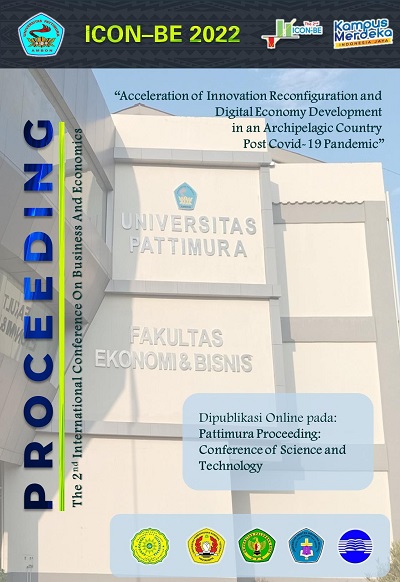ANALYSIS OF SERVICE QUALITY DESIGN WITH INTEGRATION OF KANO MODEL AND HOUSE OF QUALITY (HoQ)
CASE STUDY AT PT. MATAHARI DEPARTMENT STORE
Abstract
Introduction/Main objectives: Determine the superior service quality provided by Matahari Department Store and what attributes can satisfy customers. Background problems: Quality service is something that can distinguish one retail store from another. Consumers will compare the service received with what is expected. The quality of this service will then look good or not from the consumer's perception of the entire service process received, not the basis of the perception of the service provider. Novelty: Research about service quality using the integration of Kano Model and House of Quality in retail industry is limited. Research methods: It used integration of Kano Model and House of Quality (HoQ) with PT Matahari Department Store as the object and customer as informants. Service quality attributes are taken from Servqual. Data gathered using observation, interview, and questionnaire. Finding/Results: (1) provide input to PT. Matahari Department Store regarding strategies that can improve service quality, by identifying and prioritizing service attributes that can meet customer needs using the Servqual method and the integration of the Kano Model with the House of Quality, (2) provide input on attributes that can be developed to improve customer satisfaction. Conclusion: (1) from the identification of service quality attributes using servqual, 1 attribute with a gap score of 0 is obtained and 16 attributes have a negative score, (2) from the combined results of Servqual with Kano Model classification, 12 attributes are obtained with category O (One Dimensional) which can improve the quality of service to customers and 5 attributes with category M (Must Be), (3) from the results of the integration of Servqual and the Kano Model which is included in the House of Quality, there are 6 technical responses above an average of 6% which can be used to meet customer expectations for service quality, so that they can satisfying customers
Downloads
References
Bougoure, U.S., & Neun, M.K. (2010). Service Quality in the Malaysian Fast Food Industry: An Examination Using DINESERV. Services Marketing Quarterly, 31, 194–212.
Cohen, L. (1995). Quality Function Deployment: How to Make QFD Work for You. Addison-Wesley, Reading, MA.
Chan, L.K., & Wu, M.L. (2002). Quality Function Deployment: A Literature Review. European Journal of Operational Research, 143(3), 463-497.
Cresswell, J.W. (2016). Research Design Pendekatan Kualitatif, Kuantitatif dan Mixed. Yogyakarta. Pustaka Pelajar.
Kotler, P., & Keller, K.L. (2016). Marketing Management (15th Ed). New York. Pearson Education, Inc.
Nakhai, B., & Neves, J.S. (2009). The Challenges of Six Sigma in Improving Service Quality. International Journal of Quality & Reliability Management, 26(7), 663-684.
Ng, S., David, M. E., & Dagger, T. S. (2011). Generating Positive Word-of-Mouth in the Service Experience. Managing Service Quality: International Journal, 21(2), 133-151.
Kano, N., Seraku, N., Takahashi, F., & Tsuji, S. (1984) Attractive Quality and Must-Be Quality. Journal of the Japanese Society for Quality Control, 41, 39-48.
Parasuraman, A., Zeithaml, V.A., & Berry, L.L. (1988) SERVQUAL: A Multiple-Item Scale for Measuring Consumer Perceptions of Service Quality. Journal of Retailing, 64, 12-40.
Rangkuti, F. (2003). Measuring Customer Satisfication. Jakarta: Gramedia Pustaka.
Russell, S., & Taylor, B.W. (2011). Operations Management: Creating Value along the Supply Chain. New Jersey. John Wiley & Sons, Inc.
Sekaran, U., & Bougie, R. (2016). Research methods for business: A skill building approach. John Wiley & Sons, Inc.
Sugiyono. (2021). Metode Penelitian Kuantitatif, Kualitatif, dan R & D. Bandung. Alfabeta.
Sukardi. (2006). Penelitian Kualitatif-Naturalistik dalam Pendidikan. Jakarta: Usaha Keluarga.
Wijaya. (2011). Manajemen Kualitas Jasa: Desain Servqual, QFD, dan Kano disertai contoh Aplikasi dalam Kasus Penelitian. Jakarta. PT. Indeks.
Tan, K., & Pawitra, T. (2001). Integrating SERVQUAL and Kano's Model into QFD for Service Excellent Development. Managing Service Quality, 11(6), 418-430.
Walden, D. (1993). A Special Issue on Kano’s Methods for Understanding Customer Defined Quality. The Center for Quality of Management Journal, 2(4), 3-35.
Zeithaml, V.A., Parasuraman, A. & Berry, L.L. (1990) Delivering Quality Service: Balancing Customer Perceptions and Expectations. New York. The Free Press.
Copyright (c) 2023 Pattimura Proceeding: Conference of Science and Technology

This work is licensed under a Creative Commons Attribution-NonCommercial-ShareAlike 4.0 International License.












